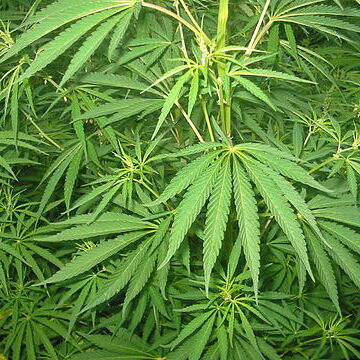Shrubs or herbs, erect or climbing, usually dioecious, annual or perennial, with aromatic granules. Leaves stipulate, opposite or alternate, simple to palmately-veined or palmately-compound. Male inflorescence paniculate; female inflorescence a spike or spike-like, the bracteate flowers usually dense and in cone-like structures. Flowers apetalous. Male flowers pedicellate; perianth 5-partite, with imbricate sepals; stamens 5, erect in bud; filaments shorter than anthers. Female flowers sessile; perianth undivided; ovary solitary, unilocular; ovule 1, pendulous; style central; stigmas 2. Fruit a nut or achene, subtended by whole or part of perianth or bract. Endosperm oily. [The above description from the Cannabaceae treatment in the Flora of Australia Volume 3 (Pearce 1989) requires revision, as it excludes Aphananthe Planch., Celtis L. and Trema Lour. which (following Australian Plant Census, accessed 18 August 2021) are now placed in Cannabaceae Martinov-Editor, 18 August 2021.]
Annual or perennial erect or climbing herbs without latex. Leaves alternate or opposite, simple, undivided or palmately lobed or divided into separate leaflets; petioles well developed; stipules present, free or fused. Flowers mostly dioecious, axillary, wind-pollinated. Male paniculate; perianth 5-partite with imbricate segments; stamens 5, opposite the tepals, the anthers straight, erect in bud, 2-thecous, at first dehiscing by apical oval pores but soon dehiscing lengthwise; vestigial ovary absent. Female ± sessile, crowded or strobilate, tightly covered or loosely subtended by small or large conspicuous persistent bracteoles; bracts also present; perianth membranous, entire, investing the ovary; ovary superior, sessile, 1-locular with 1 pendulous anatropous ovule; style terminal, short, with 2 long filiform stigmas. Fruit an achene covered by the persistent perianth; endosperm sparse, fleshy and oily; embryo curved or spirally coiled
Herbs, annual or perennial, erect or twining, dioecious or sometimes monoecious, often with cystoliths (a hard calcium carbonate structure at base of a hair). Stems furrowed or winged. Stipules free. Leaves alternate or opposite, palmately lobed or compound, sometimes simple. Male inflorescences a bracteate cymose panicle. Male flowers: pedicellate; sepals 5, free; petals absent; stamens 5, opposite sepals; filaments short; anthers 2-loculed, dehiscent by longitudinal slits. Female inflorescences a bracteate spicate cyme much reduced in Cannabis, pendent or erect. Female flowers: sessile; calyx appressed to ovary, membranous; petals absent; ovary 1-loculed; ovule solitary, pendulous from locule apex; style 2-parted, branches filiform. Fruit an achene, covered by persistent calyx; endosperm fleshy; embryo curved or spirally involute.
Female inflorescences strobilate, flowers ± sessile, crowded, tightly enclosed or loosely subtended by small or large persistent bracteoles; bracts present; perianth membranaceous, entire, investing the ovary; ovary superior, sessile, 1-locular; ovule 1, pendulous, anatropous; style terminal, short; stigmas 2, long filiform
Male inflorescences paniculate, flowers with perianth uniseriate, 5-lobed, imbricate; stamens 5, opposite the perianth lobes, anthers straight, erect in bud, 2-thecous, dehiscing at first by apical pores but soon also lengthwise; pistillode absent
Leaves alternate or opposite, petiolate, simple and undivided to palmately lobed or digitately compound; stipules free or fused
Fruit an achene covered by the persistent perianth; endosperm sparse, fleshy and oily; embryo curved or spirally coiled
Inflorescences numerous and axillary, flowers dioecious and wind-pollinated
Herbs, annual or perennial, erect or climbing, without latex


